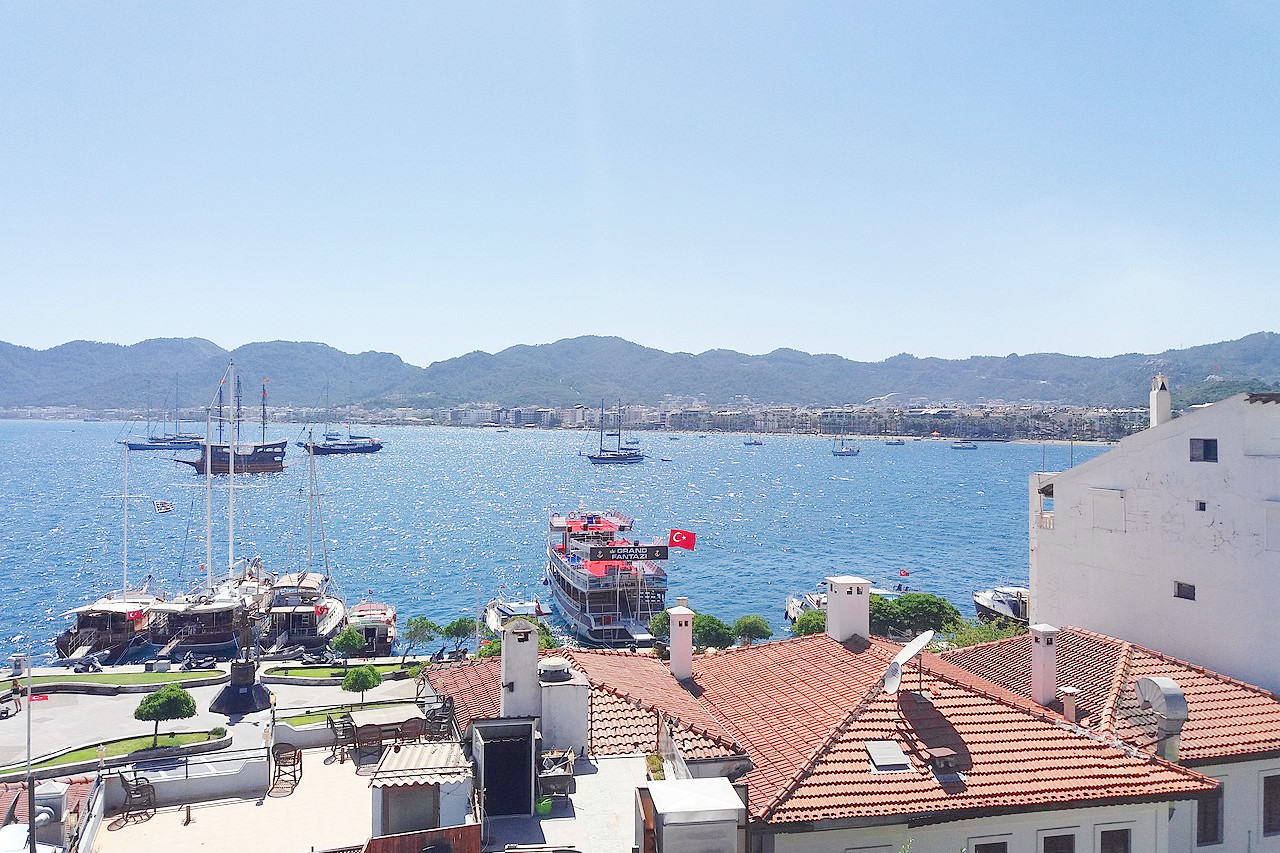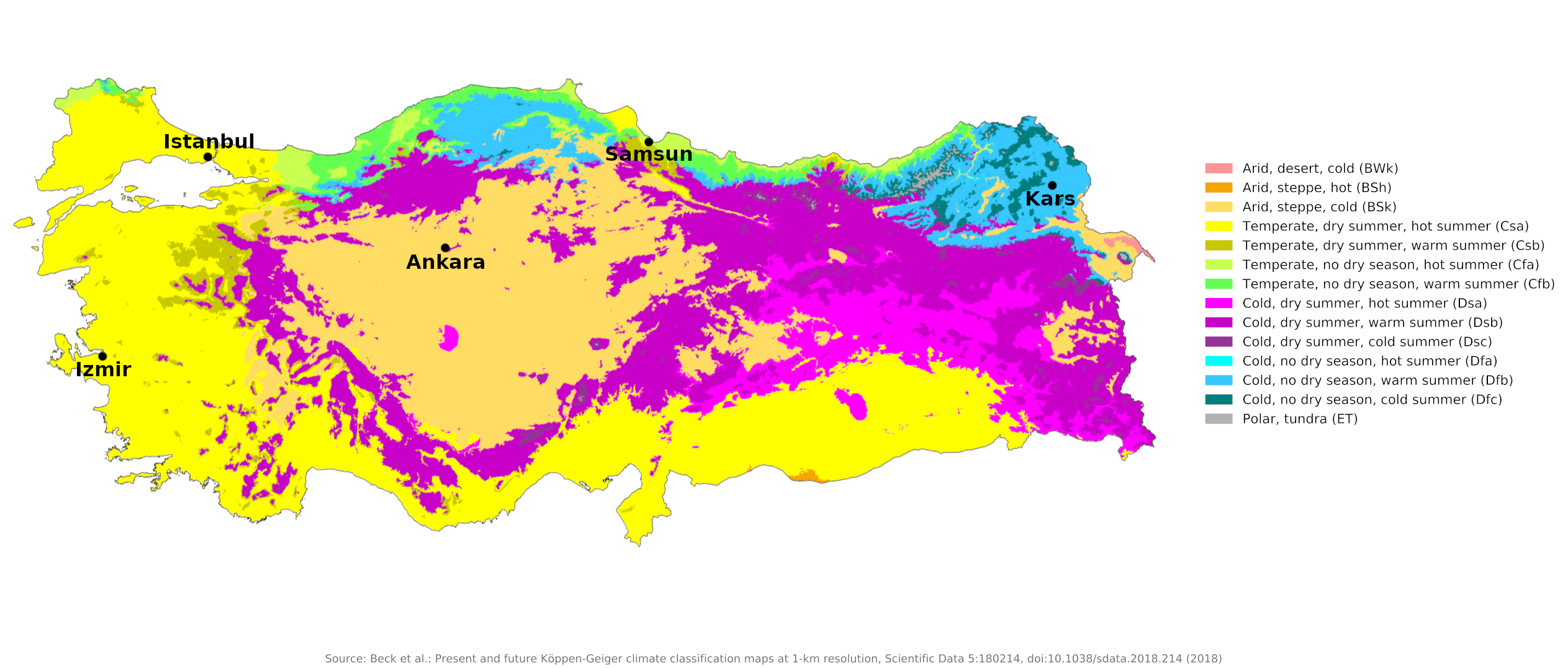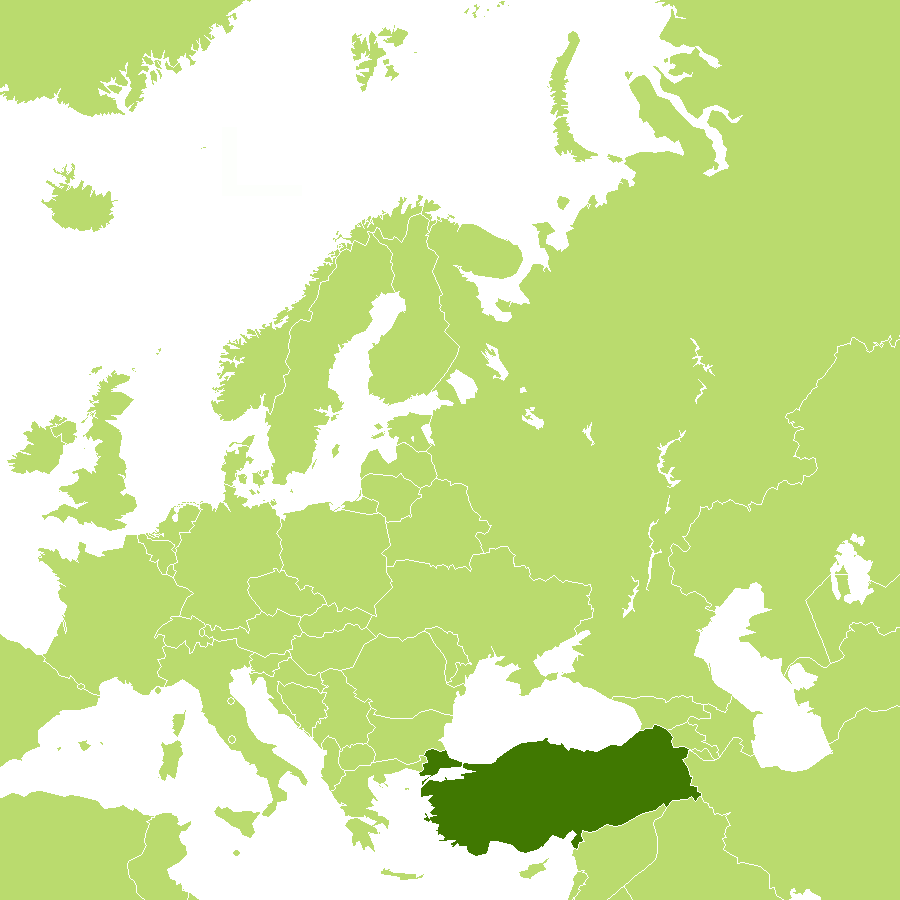The Climate of
Turkey
 Marmaris, a port city and tourist resort on the Mediterranean coast
Marmaris, a port city and tourist resort on the Mediterranean coast
Climate Map
 Climate map of Turkey
Climate map of Turkey
What is the climate of Turkey like?
Turkey is in the Middle East; It stretches 1,600 km (1,000 miles) from west to east. A small part of the country, Turkish Thrace, west of the Bosphorus, is geographically in Europe; where it borders with Greece and Bulgaria. The rest of the country, Anatolia or Asia Minor, is strictly in Asia, with borders to Iraq, Syria, Armenia, Azerbaijan, Iran, and Georgia. It has coasts on the Black Sea, the Mediterranean Sea, and the Aegean Sea.
Turkey's diverse regions have different climates, with large contrasts between the weather on the coasts with that in the interior. Anatolia—the Asian part of Turkey—consists of a high plateau that becomes more mountainous towards the east, where the country borders Georgia, Armenia, and Iran. It is bounded by the Pontic mountain ranges to the north and the Taurus and Anti-Taurus mountains to the south. These mountains and isolated volcanic peaks like Mount Ararat in eastern Turkey rise well over 3,000 meters (10,000 feet) and can carry snow all year round.
The southern part of Turkey enjoys a Mediterranean climate with an average annual temperature of 17°C to 20°C (63°F to 68°F). The narrow coasts and mountainsides overlooking the Black Sea to the north, the Aegean Sea to the west and the Mediterranean Sea to the south have wetter and milder winters than the interior. In Istanbul, the average temperatures in winter are 6°C and in summer 25°C. The northern area along the Black Sea is only slightly cooler, where winter temperatures average around 7°C (45°F) and summer temperatures average 23°C (69°F).
| Climate data for Florya, Istanbul (1991–2020) | |||||||||||||
|---|---|---|---|---|---|---|---|---|---|---|---|---|---|
| Month | Jan | Feb | Mar | Apr | May | Jun | Jul | Aug | Sep | Oct | Nov | Dec | Year |
| Average high °C (°F) | 9.2 (48.6) | 9.8 (49.6) | 12.4 (54.3) | 17.1 (62.8) | 22.2 (72.0) | 26.8 (80.2) | 29.5 (85.1) | 29.7 (85.5) | 25.8 (78.4) | 20.8 (69.4) | 15.8 (60.4) | 11.1 (52.0) | 19.2 (66.5) |
| Daily mean °C (°F) | 6.2 (43.2) | 6.3 (43.3) | 8.3 (46.9) | 12.2 (54.0) | 17.2 (63.0) | 22.0 (71.6) | 24.7 (76.5) | 25.0 (77.0) | 21.1 (70.0) | 16.7 (62.1) | 12.1 (53.8) | 8.1 (46.6) | 15.0 (59.0) |
| Average low °C (°F) | 3.7 (38.7) | 3.6 (38.5) | 5.3 (41.5) | 8.6 (47.5) | 13.4 (56.1) | 17.8 (64.0) | 20.5 (68.9) | 21.1 (70.0) | 17.4 (63.3) | 13.6 (56.5) | 9.3 (48.7) | 5.7 (42.3) | 11.7 (53.0) |
| Average precipitation mm (inches) | 72.0 (2.83) | 78.8 (3.10) | 61.0 (2.40) | 51.5 (2.03) | 30.2 (1.19) | 31.5 (1.24) | 19.8 (0.78) | 26.1 (1.03) | 44.7 (1.76) | 80.4 (3.17) | 69.3 (2.73) | 87.3 (3.44) | 648.0 (25.51) |
| Source: Meteoroloji Genel Müdürlüğü | |||||||||||||
Turkey's mountains prevent Mediterranean influences from extending inland, giving the interior of Turkey a continental climate with distinct seasons. The Anatolian Plateau is much more subject to extremes than are the coastal areas. The Central Plateau region experiences great daily and seasonal temperature variations, with cold winters and hot summers. Except at higher elevations, inland summers are warm or even hot with occasional thunderstorms. The inner plateau has low rainfall and cold or very cold winters. See the climate of Ankara.
| Climate data for Ankara (1991–2020) | |||||||||||||
|---|---|---|---|---|---|---|---|---|---|---|---|---|---|
| Month | Jan | Feb | Mar | Apr | May | Jun | Jul | Aug | Sep | Oct | Nov | Dec | Year |
| Average high °C (°F) | 4.7 (40.5) | 7.4 (45.3) | 12.2 (54.0) | 17.5 (63.5) | 22.8 (73.0) | 27.3 (81.1) | 31.0 (87.8) | 31.0 (87.8) | 26.5 (79.7) | 20.3 (68.5) | 13.0 (55.4) | 6.7 (44.1) | 18.4 (65.1) |
| Daily mean °C (°F) | 0.9 (33.6) | 2.7 (36.9) | 6.7 (44.1) | 11.5 (52.7) | 16.5 (61.7) | 20.6 (69.1) | 24.2 (75.6) | 24.3 (75.7) | 19.6 (67.3) | 13.9 (57.0) | 7.3 (45.1) | 2.8 (37.0) | 12.59 (54.66) |
| Average low °C (°F) | −2.2 (28.0) | −1.2 (29.8) | 1.9 (35.4) | 6.0 (42.8) | 10.5 (50.9) | 14.1 (57.4) | 17.2 (63.0) | 17.4 (63.3) | 13.1 (55.6) | 8.4 (47.1) | 2.7 (36.9) | −0.3 (31.5) | 7.3 (45.1) |
| Average precipitation mm (inches) | 38.6 (1.52) | 36.6 (1.44) | 46.9 (1.85) | 44.5 (1.75) | 51.0 (2.01) | 40.2 (1.58) | 14.8 (0.58) | 14.6 (0.57) | 17.9 (0.70) | 33.4 (1.31) | 31.9 (1.26) | 43.2 (1.70) | 413.6 (16.28) |
| Source: Meteoroloji Genel Müdürlüğü | |||||||||||||
The eastern region has higher elevations and cooler temperatures (see the climate for Kars). Winter snow can lie on the ground for three to four months, with lows of -30°C to -38°C (-22°F to -36°F). The average winter temperature in the east is around -10°C (14°F) and summer is 18°C (65°F).
| Climate data for Kars (1991–2020) | |||||||||||||
|---|---|---|---|---|---|---|---|---|---|---|---|---|---|
| Month | Jan | Feb | Mar | Apr | May | Jun | Jul | Aug | Sep | Oct | Nov | Dec | Year |
| Average high °C (°F) | −3.2 (26.2) | −1.2 (29.8) | 4.9 (40.8) | 12.3 (54.1) | 17.3 (63.1) | 22.2 (72.0) | 26.3 (79.3) | 27.3 (81.1) | 23.0 (73.4) | 16.1 (61.0) | 7.5 (45.5) | −0.4 (31.3) | 12.7 (54.9) |
| Daily mean °C (°F) | −9.4 (15.1) | −7.7 (18.1) | −1.0 (30.2) | 5.7 (42.3) | 10.4 (50.7) | 14.5 (58.1) | 17.9 (64.2) | 18.4 (65.1) | 14.1 (57.4) | 8.2 (46.8) | 0.6 (33.1) | −6.2 (20.8) | 5.5 (41.9) |
| Average low °C (°F) | −14.8 (5.4) | −13.4 (7.9) | −6.3 (20.7) | −0.2 (31.6) | 4.3 (39.7) | 7.4 (45.3) | 10.5 (50.9) | 10.7 (51.3) | 6.1 (43.0) | 1.5 (34.7) | −4.8 (23.4) | −11.2 (11.8) | −0.8 (30.6) |
| Average precipitation mm (inches) | 23.2 (0.91) | 21.4 (0.84) | 33.1 (1.30) | 57.0 (2.24) | 83.6 (3.29) | 75.0 (2.95) | 65.1 (2.56) | 45.1 (1.78) | 29.7 (1.17) | 44.6 (1.76) | 26.6 (1.05) | 25.6 (1.01) | 530.0 (20.87) |
| Source: Meteoroloji Genel Müdürlüğü | |||||||||||||
The coastal regions have much milder winters and snow is rare here. In Turkish Thrace around Istanbul and on the Black Sea coast, it is slightly colder in winter than on the west and south coasts (see the climate of Samsun on the Black Sea coast). Adequate rainfall of about 580 to 1,300 millimeters (23 to 51 inches) falls along the Mediterranean coast and west coast of the Aegean. The region bordering the Black Sea is also well-watered, with annual rainfall ranging from 710 to 2,200 millimeters (28 to 87 inches). On the Black Sea coast it rains all year round and east of Samsun it gets heavy in summer and autumn. Summers here are warm and humid and the weather is often changeable and cloudy. South of Istanbul, on the Aegean and Mediterranean coasts, there is a typically Mediterranean climate with increasingly dry, hot summers (see the climate of Izmir on the Aegean coast). Here, midwinter is the rainy season, when there are frequent changes in weather.
| Climate data for Samsun (1991–2020) | |||||||||||||
|---|---|---|---|---|---|---|---|---|---|---|---|---|---|
| Month | Jan | Feb | Mar | Apr | May | Jun | Jul | Aug | Sep | Oct | Nov | Dec | Year |
| Average high °C (°F) | 11.1 (52.0) | 11.3 (52.3) | 12.8 (55.0) | 15.3 (59.5) | 19.4 (66.9) | 24.4 (75.9) | 27.4 (81.3) | 28.2 (82.8) | 24.8 (76.6) | 20.8 (69.4) | 16.7 (62.1) | 13.1 (55.6) | 18.8 (65.8) |
| Daily mean °C (°F) | 7.5 (45.5) | 7.3 (45.1) | 8.7 (47.7) | 11.3 (52.3) | 15.9 (60.6) | 20.8 (69.4) | 23.9 (75.0) | 24.5 (76.1) | 20.9 (69.6) | 17.0 (62.6) | 12.6 (54.7) | 9.4 (48.9) | 15.0 (59.0) |
| Average low °C (°F) | 4.4 (39.9) | 4.1 (39.4) | 5.2 (41.4) | 7.9 (46.2) | 12.4 (54.3) | 17.0 (62.6) | 20.0 (68.0) | 20.7 (69.3) | 17.3 (63.1) | 13.6 (56.5) | 9.1 (48.4) | 6.5 (43.7) | 11.5 (52.7) |
| Average precipitation mm (inches) | 72.5 (2.85) | 53.5 (2.11) | 68.5 (2.70) | 54.0 (2.13) | 54.1 (2.13) | 51.6 (2.03) | 38.9 (1.53) | 47.2 (1.86) | 51.8 (2.04) | 79.0 (3.11) | 76.1 (3.00) | 82.5 (3.25) | 729.7 (28.73) |
| Source: Meteoroloji Genel Müdürlüğü | |||||||||||||
| Climate data for İzmir (1991–2020) | |||||||||||||
|---|---|---|---|---|---|---|---|---|---|---|---|---|---|
| Month | Jan | Feb | Mar | Apr | May | Jun | Jul | Aug | Sep | Oct | Nov | Dec | Year |
| Average high °C (°F) | 12.7 (54.9) | 14.0 (57.2) | 17.2 (63.0) | 21.3 (70.3) | 26.5 (79.7) | 31.3 (88.3) | 33.8 (92.8) | 33.6 (92.5) | 29.5 (85.1) | 24.6 (76.3) | 18.8 (65.8) | 14.0 (57.2) | 23.1 (73.6) |
| Daily mean °C (°F) | 9.0 (48.2) | 9.9 (49.8) | 12.4 (54.3) | 16.2 (61.2) | 21.1 (70.0) | 26.0 (78.8) | 28.6 (83.5) | 28.5 (83.3) | 24.2 (75.6) | 19.5 (67.1) | 14.4 (57.9) | 10.5 (50.9) | 18.4 (65.1) |
| Average low °C (°F) | 6.0 (42.8) | 6.6 (43.9) | 8.6 (47.5) | 11.8 (53.2) | 16.2 (61.2) | 20.9 (69.6) | 23.5 (74.3) | 23.7 (74.7) | 19.5 (67.1) | 15.4 (59.7) | 10.9 (51.6) | 7.7 (45.9) | 14.2 (57.6) |
| Average precipitation mm (inches) | 127.5 (5.02) | 107.2 (4.22) | 77.8 (3.06) | 50.1 (1.97) | 32.9 (1.30) | 14.4 (0.57) | 3.0 (0.12) | 6.7 (0.26) | 23.5 (0.93) | 56.5 (2.22) | 99.6 (3.92) | 131.3 (5.17) | 730.5 (28.76) |
| Source: Meteoroloji Genel Müdürlüğü | |||||||||||||
The Taurus Mountains along the Mediterranean prevent rain from reaching the heart of the country, which is therefore much drier, with annual rainfall ranging from 400 to 700 millimeters (16 to 28 inches). The low rainfall on the central plateau is usually concentrated in the late autumn and winter months. The hottest and driest area of Turkey in summer is the lowlands at the foot of the Taurus Mountains along the border with Syria. Here conditions become typical of the Middle East. The region is a semi-arid steppe with only winter rains.
With the exception of the eastern part of the Black Sea coast, most of Turkey has a very sunny climate, even in winter. Average daily sunshine hours range from three to four hours in the middle of winter to twelve to thirteen hours in summer. Although summer temperatures are quite high, the heat is tempered by low humidity inland and sea breezes along the coast. Occasionally nights can be muggy and muggy on the Aegean and Mediterranean coasts. The worst feature of the climate is the severe cold experienced inland in winter and occasionally early spring.
References
- E. A. Pearce, Charles Gordon Smith, (1990) The Hutchinson World Weather Guide, John Murray Press. ISBN 1859863426
- Timothy L. Gall, (ed.), (2003), Worldmark Encyclopedia of the Nations, Eleventh Edition, Thomson Gale
- Federal Research Division, Library of Congress, (1986), Turkey: a country study. Claitor's Pub. Division. ISBN 0844408646
- Hugh Chisholm, (ed.), (1911), Encyclopædia Britannica, Eleventh edition, Cambridge University Press
The Climate of
Turkey

In summary:
The southern part of Turkey enjoys a Mediterranean climate, with a mean annual temperature of 17°C to 20°C (63°F to 68°F). In Istanbul, temperatures average 6°C (43°F) in winter and 25°C (77°F) in summer. The northern Black Sea coast is slightly cooler, where winter temperatures average about 7°C (45°F) and summer temperatures average 23°C (69°F). The central plateau region experiences a continental climate, with cold winters and hot summers. The eastern region has higher elevations and temperatures there are cooler, with 120 days of snow cover and an average winter temperature of -13°C (21°F) and in summer, 17°C (63°F).
Adequate rainfall of about 580 to 1300 mm (23 to 51 in) occurs along the Mediterranean coast and the western coast of the Aegean Sea. The region bordering the Black Sea is also well watered, with annual rainfall in the range of 710 to 2200 mm (28 to 87 in). The Taurus Mountains along the Mediterranean prevent rain from reaching the heart of the country, which is therefore much drier, with annual rainfall between 56 to 71 mm (22 to 28 inches).